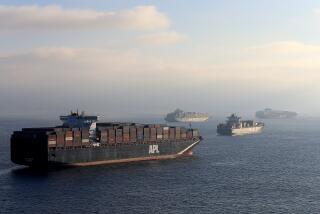Dust Bowl Tied to Shifts in Ocean Surface Temperatures
- Share via
LUBBOCK, Texas — Will-Allen Jameson remembers the sound that the huge, rolling wall of dust made before it reached her family’s west Texas ranch.
“You could kind of hear a faint roar, and it would get real quiet,” said the 76-year-old author as she described one of the many dust storms that she witnessed as a youngster. “Birds were alarmed. They could sense something was coming up.”
It was the Dust Bowl days of the 1930s, a time when drought choked the Great Plains stretching across Texas, Oklahoma, Kansas, New Mexico and Colorado. Soil from America’s breadbasket filled the skies. Sometimes a single dust storm lingered for days.
The storms were the result of drought and poor agricultural practices. Grasslands, which held soil in place, had been plowed and replanted with wheat. With rain, the crop was abundant. But when drought struck in the 1930s, farmers continued to plow and plant. With no ground cover remaining, the winds whipped the soil skyward.
More than 70 years later, a NASA scientist studying moisture and air patterns in the atmosphere believes that he may have stumbled upon why the drought occurred in the first place.
Siegfried Schubert, a meteorologist at NASA’s Goddard Space Flight Center in Greenbelt, Md., wrote in a study that slight changes in the surface temperatures of two oceans created atmospheric conditions that caused the Dust Bowl from 1931 to 1939.
“The 1930s drought was the major climatic event in the nation’s history,” Schubert said. “Just beginning to understand what occurred is really critical to understanding future droughts and the links to global climate change issues we’re experiencing today.”
In the 1930s, tropical Pacific Ocean temperatures were cooler than normal and tropical Atlantic Ocean temperatures were warmer than normal, producing a weakened low-level jet stream that sent it farther south, he said. The variation in sea surface temperatures was only a few tenths of a degree centigrade.
The jet stream normally moves westward over the Gulf of Mexico before turning northward, bringing moisture and rain to the Great Plains. The weakened jet stream in the 1930s also carried less moisture, and Great Plains farmland dried up.
For the next nine years, yellow-brown dust blew on the southern plains; walls of black dust rolled across the northern plains. Breathing became a chore. Children donned dust masks to go to and from school, and wet sheets were used to try to stop dust from getting into homes. Farmers looked on in despair as their crops blew away.
Schubert said his study was aimed at evaluating an atmospheric circulation model that NASA devised using satellite observations.
He and his colleagues used data taken from ship records to create starting atmospheric conditions for the model. They then let the model run on its own and used only observed monthly global sea surface temperatures.
“Right now, what we need to do is find out what caused those sea surfaces’ temperatures,” Schubert said. “We need to understand the whole system, the ocean and the atmospheric.”
The study, published in March in Science magazine, also found that droughts can be localized because of soil moisture levels, particularly during the summer. When rain is negligible, less evaporation occurs and that leads to even less rain.
John M. Wallace, professor of atmospheric sciences at the University of Washington in Seattle and one of those who reviewed the study for Science, called the findings invaluable -- the first to make a persuasive case between rainfall on the Great Plains and the sea surface temperatures in the tropics.
“It doesn’t make any exceptional claims but it just identifies one of the factors that can influence the summer rainfall over the southern United States,” he said. “Their paper is really quite modest in claiming what this will give us. It won’t enable us to say, ‘This is going to be a drought year.’ But it will enable us to get a feeling for the odds, the probabilities.
“Anything that can get a leg up on what’s coming next summer is going to be useful.”
More to Read
Sign up for Essential California
The most important California stories and recommendations in your inbox every morning.
You may occasionally receive promotional content from the Los Angeles Times.










